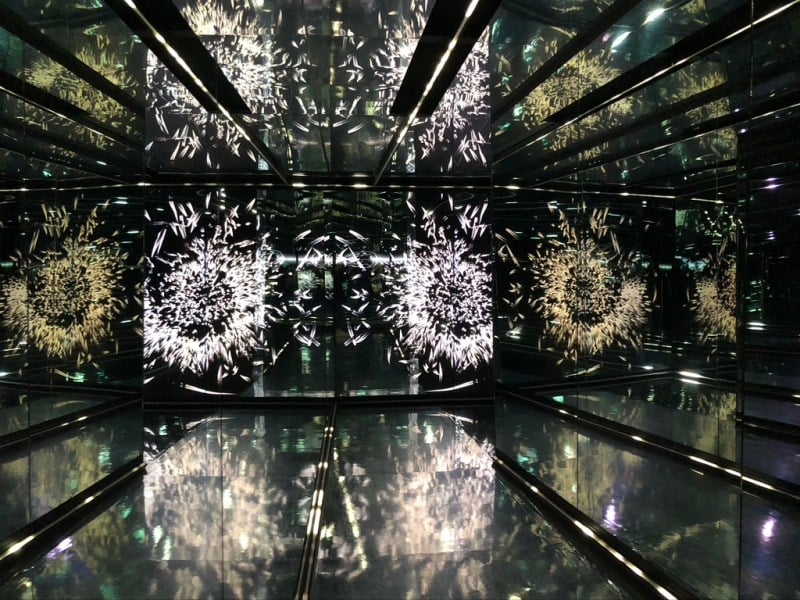I stand on the International Space Station in front of an astronaut who tosses a ball past me. Instead of going over my shoulder, the ball passes right through me — in virtual reality (VR), both the ball and the space station only exist in my goggles.
“Space Explorers: THE INFINITE,” an interactive exhibit in Richmond, California, allows attendees to experience the International Space Station (ISS) in VR. It also features an immersive art show by Ryoji Ikeda, “The Universe within the Universe.” The experience takes about an hour total, with 35 minutes spent in “space,” after which attendees are allowed to wander through Ikeda’s art exhibit.
Both the VR and art portions of the exhibit were incredible; though the experience was occasionally rough around the edges, the positive elements of the exhibit far outnumbered the negatives. The VR visit to the ISS was impressively entertaining and educational, and Ikeda’s art installation, which incorporated moving lights and audio, was equally engaging.
The VR component of the exhibit takes place in a large room with a plain three-dimensional model of the ISS, in front of a backdrop of stars. Glowing orbs float throughout the room and, when touched, expand to engulf the viewer in various types of immersive exhibits. There are many more orbs than there is time to press them, so most attendees leave with their own unique experience. It’s also possible to coordinate with friends and grab the same orb: in the VR world, the avatars of people within your party, strangers and staff are assigned different colors, so it’s easy to differentiate.
Some of my favorite orbs put us inside the ISS with astronauts on board. All of the footage was taken on the ISS, so the experience felt incredibly realistic. The orbs contained information about the history of space exploration or the astronauts’ lives aboard the ISS, and I found these mini-exhibits to be incredibly fun ways to learn. In other cases, the orbs displayed views of space from the ISS.
On average, these orbs are more immersive than the rest of the VR exhibit, as their model of the ISS lacks lifelike detail. Walking around outside of the orbs was enjoyable but nowhere near as impressive or immersive as the experience within the orbs.
Still, getting to choose which orb to select was exciting, as there was nothing to indicate what each orb contained. The anticipation of the orb expanding and then beginning to display its own mini-exhibit was incredible.
Additionally, small objects such as a ball or a watch appear at random, allowing attendees to “grab” the objects and bat them around as if they were in zero gravity. At times, both me and my friend could see the same objects, and we had tons of fun playing VR-catch with them. However, at times one of us would see an object that the other did not, which led to a bit of frustration as one of us kept searching for an object that was not there.
From the beginning, the exhibit was set up to immerse viewers. The entry hall had a minimalist aesthetic, with lots of glowing lights and smooth black walls, which made me excited about the experience even before strapping on my VR goggles. Once past the entry hall, even the way in which the VR goggles were stored added to the immersive atmosphere. I audibly gasped when I saw the goggles lined up in their glowing tubes.
One of my favorite parts of the exhibit was at the end, when we were seated at a chair and got to see the earth rise in front of us. It was such a breathtaking and awe-inspiring view; from our seats, the earth was enormous, taking up almost our entire field of view. Our view of the earth perfectly reflected what it would have looked like from the ISS, and this view is not one that I will be forgetting soon.
I was also very impressed that I did not get nauseous during the experience. I tend to feel sick after being in VR for more than 15 minutes, but that wasn’t the case in this exhibit despite it taking more than twice the time. When entering the exhibit, one of the staff members mentioned that we would be using a new version of the Oculus headsets, which I suspect helped me feel less nauseous. The exhibition also has non-VR options in case attendees feel too nauseous to continue.
At this point in the exhibit I had a message pop up in front of me telling me that my headset had low battery, which interrupted my immersion a bit. Thankfully, one of the staff members came over and quickly resolved the issue for me, allowing me to finish without any trouble. All of the staff members were incredibly helpful and friendly, and very enthusiastic about the exhibit.
Ikeda’s art installation was a great end to the exhibition. After going to space, I wasn’t quite ready to come back to the real world yet, so I loved getting time to explore Ikeda’s exhibit. “The Universe within the Universe,” described as “an ode to the cosmos’ hidden mysteries,” emulates the sense of weightlessness in space through a mirrored hallway filled with moving lights and a soundtrack. Using both art and VR to explore the experience of space from different angles was effective, and the two media complemented each other nicely. The moving lights were mesmerizing to watch, and walking through the hall of mirrors while the exhibit’s soundtrack played was also an enjoyable experience.
From the ISS to the hall of mirrors, every element of the experience was engrossing, allowing for a unique and unforgettable exhibit.
Editor’s Note: This article is a review and includes subjective thoughts, opinions and critiques.
